The Top Quarterback Prospects to Watch Ahead of the 2024 Draft

In many years, we all jump the gun in talking about the upcoming draft-eligible quarterbacks over the summer.
This is not one of those years.
And it’s not just one player you can mark down to have his name called in the 8 p.m. hour of draft night, nine-and-a-half months from now. This year, we got two.
We’re reprising the dive we’d do years ago on the following year’s quarterback prospects, which was part of our old draft week coverage. I figured this was the year to bring it back, for one obvious reason, plus another that’s becoming increasingly apparent. The former being that USC Heisman winner Caleb Williams isn’t the kind of prospect that comes around every year at the position; the latter that North Carolina’s Drake Maye would probably be a high first-round pick in just about any draft class.
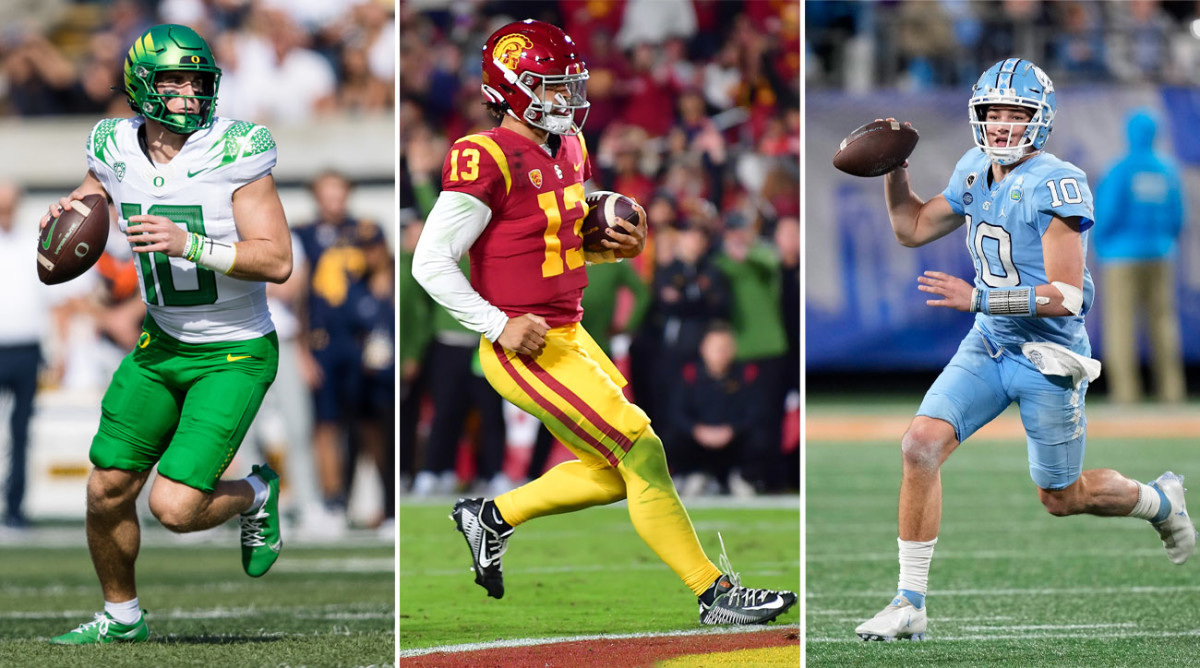
Those two, to be sure, are on separate planes, and that gives scouts a lot of early material to dig into for 2024. But what is really interesting is, after those two, there is a pretty sizable cluster of talented prospects (with a lot to prove), which should make for a very interesting fall. This also brings a lot of uncertainty as to how many players are worthy of going in the first round, and the top 100 or so picks.
“I think you have one guy, a drop-off, another guy, and I think there’s another drop-off, and that drop-off is bigger,” said one AFC scouting director who’s gotten some early study in on the class. “You have a lot of suspects right now—it’s a good quarterback group. But it’s gonna take a lot of work stacking them up, and vetting them out. So it’s 1, line, 2, line, then a big group at 3 right now. It’s a big clump of quarterbacks that are pretty good.”
To sort through all of it, we went back to my old formula. I enlisted Summit QB founder and trainer Jordan Palmer, and UAB coach Trent Dilfer, both of whom played in the NFL, have experience coaching the position at various levels, and, through Elite 11, have known a good number of the prospects since they were teenagers. They were both willing to share their thoughts on the class, and to accompany them, I reached out to a number of scouting director/executives types who’ve already looked at the group, as well as Senior Bowl executive director Jim Nagy.
The idea, of course, is to give you a cheat sheet on the class heading into the fall.
So here we go with that cheat sheet …
Caleb Williams
Junior, University of Southern California
I’ve been doing this long enough to remember how NFL folks talked about Andrew Luck leading up to 2012, and Trevor Lawrence leading up to ’19. For me, over two decades into covering the league, the standing those players held with scouts en masse was without parallel. Until now. Williams is the newest member of a group exclusive enough, over the last half-century, to only have four members.
Those four: Lawrence, Luck, Peyton Manning and John Elway. Williams could make five.
“So I’ve been around Caleb since he was a junior in high school,” Palmer said. “This is the only time I’ve ever said this about a kid in the Elite 11 process, which is where I’m at right now, I was with Caleb last night and the night before—this is the best kid I’ve ever seen, at this point. When Caleb was coming out of high school, I thought it was really, really clear that that was the case.
“Totally subjective, but this is the 25th anniversary of Elite 11. I’m the only person that’s been to all 25. I’ve seen everybody come through it. And when it’s all said and done, I think a lot of people are going to think that way about the draft too. They’re going to say this is the best, or one of the best guys we’ve seen at this phase in their career, entering the draft.”
“He’s rare,” Dilfer added. “I always go to these car analogies because they resonate with people the most, but he’s got muscle car horsepower, he’s got sports car twitch, he’s got SUV joint structure, he’s got Tesla brains. And he’s got Formula 1 intuitive qualities. He’s just everything you’re looking for. We had him that COVID year at Elite 11 and I was just like, Guys, am I crazy or is this maybe the best kid we’ve ever had? He’s unbelievable.
“He’s got this magnetic personality. People are drawn to him. He’s got humility. He just checks every box. And then he plays the position at a high level in one of the better structured offenses in college football. There’s just nothing that you don’t have in him. I can’t wait for the one scout that tries to tear him apart, like they did with Andrew Luck.”
Maybe—maybe—that Williams has a different type of personality is what gets picked at by NFL types. But that’s really just it. You have to reach to criticize a guy who became Lincoln Riley’s first true-freshman starting quarterback at Oklahoma, then transferred and became USC’s pied piper in winning the Heisman as a sophomore.
“You have guys that have unique twitch but they lack horsepower, you have guys that have unique horsepower but they lack twitch,” Dilfer said. “What you’re really looking for is this twitch/horsepower combination. There’s no way of quantifying it, except with your eye. Caleb has that. He can play the game like a twitchy little 5'11" kid that’s lightning in a bottle, and he can play the power game like the most powerful guy in the NFL. It’s Aaron Rodgers.”
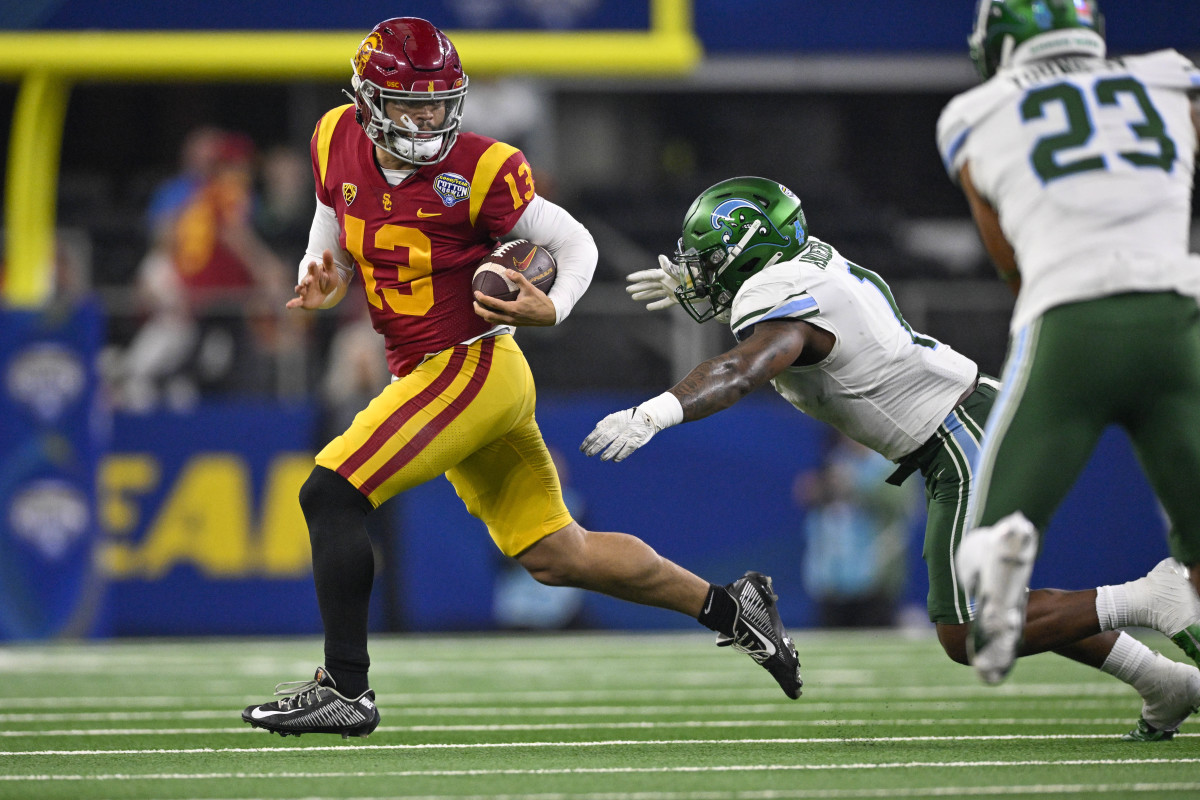
So there’s one comparison. The comp Williams has gotten most from NFL folks who’ve watched his tape—and lots of their eyes were pulled to the quarterback in the spring when they were studying USC’s offensive players, or Pac-12 defenders—is actually Patrick Mahomes. And even when you ask about that, what could sound like hyperbole follows.
“I think it’s fair,” Palmer said “I just think that Caleb’s just way more athletic than Patrick. And a way better runner. So yeah, I do think it’s similar, except Caleb’s an attacking runner, he attacks the defense. And there’s a lot of quarterbacks, great quarterbacks, Patrick and Joe [Burrow] and guys that … if there’s a crease, they’ll get it. And if there’s an opportunity to get upfield and cut back and replace a defender, they’ll get it and they’re mobile enough to go and do that. But they don’t attack.”
Dilfer did reference what he calls the “Mock Draft Boulder” that Williams will be carrying around all season. Which would be a concern, if he didn’t already have to start at Oklahoma at 18 years old, or help pull together a USC program that was microwave-rebuilt through a version of college free agency. And as if you’d need more, to put a bow on all this, Palmer brought up a critical play Williams made as a freshman at Oklahoma, against Kansas State.
Oklahoma was up 28–23, on fourth-and-1 with less than four minutes left. Williams handed the ball off and his back got stacked up at the line. Standing nearby, the QB made the snap decision to step in before the whistle could be blown, and rip the ball from his teammate, then run it for the first down himself. It was funny in the moment. But with time, it proved to be more than that: another piece of evidence of the kind of playmaker he is.
“There’s just a bunch of those plays where he made that play because he was going to figure out a way to make a play in that moment,” Palmer said. “There are really good quarterbacks that I wouldn’t say that about—real good ones. … His best attribute is his competitiveness. So when you think about the way that Aaron, and I think Pat’s doing this now, then really Joe, taking the Bengals to the Super Bowl, it’s like you’re waiting for them to win, no matter what’s happening in the game. Essentially, I think Caleb’s one of those guys too.”
Which means, at least for now, there’s little doubt who’s No. 1.
Drake Maye
Redshirt sophomore, North Carolina
If there’s one thing that comes up consistently with Maye, it’s that, while he may not bring any physically overwhelming trait, everything he does looks easy and natural.
“I have nothing bad to say about Drake,” Dilfer said. “But it’s different now. This is not apples to apples. Drake Maye has what you call the gift of smooth. Drake, yes, has good horsepower, yes, has good twitch. But really his gift is making hard things look easy. He’s very fluid, he’s very smooth, he’s a good processor, he has good athletic traits, not great. He’s more of a wing forward in basketball, where Caleb is the dynamic scorer.”
“Because of Caleb and because of how notable he is, Drake’s not going to get the attention that he would’ve gotten from other drafts, because I think he’d be 1 in other drafts,” Palmer added. “You’re just going to hear a lot of [Justin] Herbert and Josh Allen. Josh, Herbert, you’re going to hear a lot of that when the evaluators start evaluating. He’s a big guy but he’s really, really fluid, really smooth.”
Where Maye differs a bit from Allen and Herbert is in the power those two bring to the game, and in how, because of his background, he’s less raw than the other two were. As Dilfer talked me through what he was seeing, I raised Burrow’s name as a comp in response to what he was describing.
“Yes, thank you, he’s Burrow,” Dilfer said. “That’s exactly who he is, he’s Joe Burrow, who we know is one of the great players in the NFL. So there’s nothing negative here. It’s more like, let’s get our analogies right. Burrow’s a very good athlete, he was a very good high school basketball player, he’s a great competitor, but what separates Joe Burrow is this innate quality, this nuance to his game, that people want to say is something that’s it’s not because you don’t know how to define it, instead of just saying I don’t know how to define it.
“It’s nuanced. … Joe makes everything look easy.”
The interesting thing is part of what makes him look so natural is genetic.
He’s a second-generation Tar Heel quarterback: his dad, Mark, started for two years at UNC. His brother Luke was a standout in the school’s powerhouse basketball program. Another brother, Cole, won a national title playing baseball at Florida. So if NFL teams see a player who already carries himself like a pro (and Maye does), they know that’s no accident.
“Ironically, he played for Josh McCown when Josh took a year off of football and he was coaching high school and his sons,” Palmer said. “And honestly, really similar personality. Talks kind of the same. You see a lot of McCown in his personality and it’s like, Albert, we’ve talked about this, McCown, I’ve learned as much from that guy as any teammate I’ve ever had and he was probably one of my most impressive teammates I’ve ever been around, from a personality standpoint.”
While Maye may not be Williams, some team will be pretty happy pulling his name off the board very close to the top of the draft.
Bo Nix
Redshirt senior, Oregon
One refrain I got from an experienced scouting director on Nix: No one should be surprised if we all wake up next April, and he is, say, the 25th pick in the draft.
There are a few things Nix has in spades. The battle-hardened super senior is a very good athlete. He’s tough. He’s got enough arm. And he has a lot of starts—47 of them, to be exact, with a chance to get to 60 if he stays healthy through his final season as a Duck.
“From a ceiling perspective, being that next quarterback on the board wouldn’t be too high,” Palmer said. “He’s got the tools to be considered a first-round pick and really, really underrated athleticism. He’s fast for a fast guy. Not kind of fast for a quarterback. He’s going to have a lot of productivity this year.”
Palmer, who’s worked with Nix, did concede that some of the Auburn tape was rough. The question for most is: How much of that do you chalk up to a system that was, well, not exactly the most respected one in college football, among NFL folks? One exec said to me that he’d admit it’s hard for him to “unsee” what he saw from Nix as a Tiger.
On the flip side, last year, Nix broke through with a veteran line in front of him and Kenny Dillingham as his offensive coordinator. This year, then, will be an interesting proving ground, with Dillingham gone and a younger group around the quarterback.
“He can run around, and he eliminated a lot of his bad decision-making last year,” said another veteran evaluator. “I think he’s better than [Will] Levis, and no ill will towards Will, it was just the more I watched Will, the less I liked him. Bo’s the opposite. He’s heading in the right direction, and I’d think he could be a fringe first-rounder like Will was.”
One thing that will help Nix is, in all likelihood, the intangible piece.
“He’s that kind of guy, his teammates are gonna die for him,” said Dilfer, who conceded some bias since he’s known Nix since he was a middle-schooler. “He’s got that toughness, I don’t know if there’s a better term for it, physical and mental toughness, resilience, grit, and packaged in a good body, as a really good athlete, that has become a much better thrower.”
Michael Pratt
Senior, Tulane
Pratt’s story is a fascinating one: He was home-schooled through the eighth grade, and he didn’t play football until high school. Going into his fourth year as a starter at Tulane, he crept on to the NFL radar last year as the Green Wave won the AAC and beat USC in the Cotton Bowl.
“We play them this year, as we’ve studied him, he’s a very, very good football player,” Dilfer said. “I think he’s the one that comes out of nowhere. He’s got really good physical traits, he’s coached really well, he’s asked to do a lot, they’re very sophisticated offensively so he handles a lot of really high-level stuff. He’s playing professional quarterback in college.
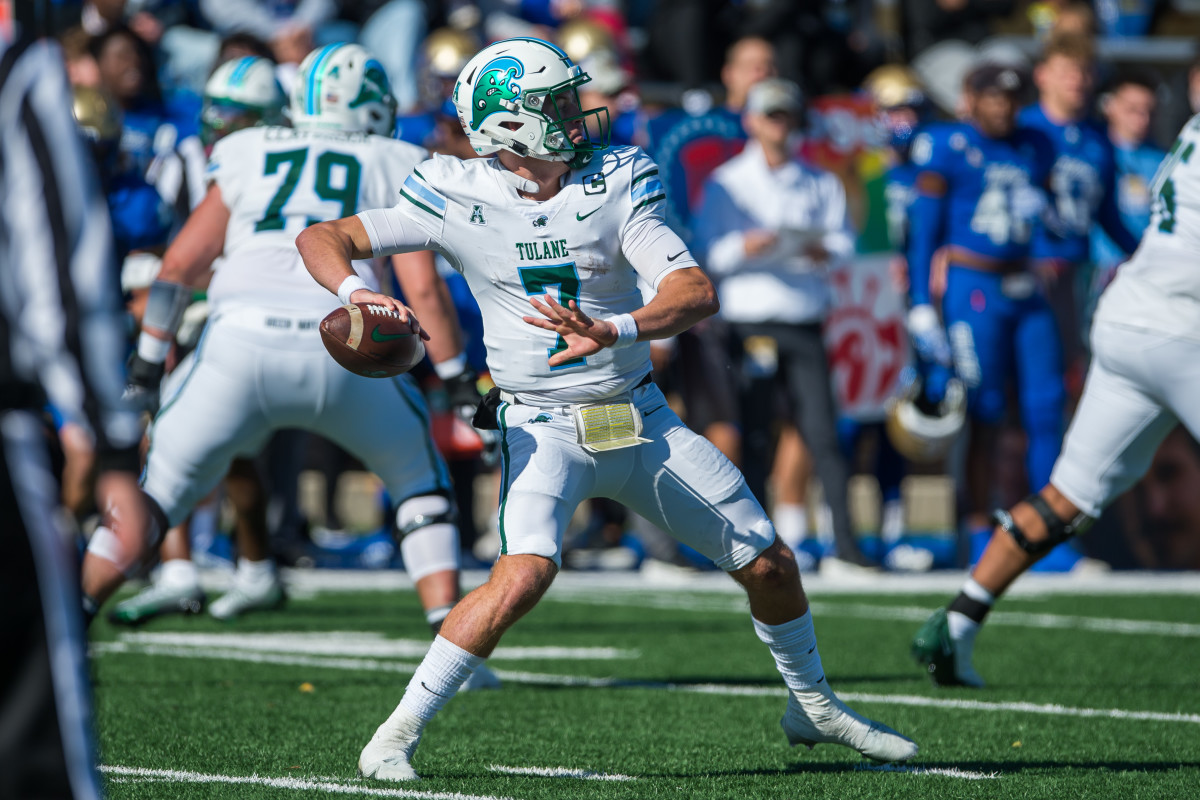
“Willie [Fritz] and that staff make him play, they demand a certain aptitude and physical ability from the position much like we do, much like Sark [Texas coach Steve Sarkisian] does, much like Alabama does, much like Georgia does. It’s just different. They’re asked to do more. They’re asked to be pros while they’re in college. And that’s gonna carry over.”
The question with Pratt will be how high his physical traits justify him going. He’s listed at 6'3", 220 pounds, so, if that checks out officially, he’s got the requisite size. And he was lights out for stretches last year.
The larger question will be, since he’s still relatively new to the game, how much room there remains for growth. Dilfer sees “a bigger version of [Jake] Haener” in Pratt.
Haener was taken in the fourth round last year by the Saints.
Jordan Travis
Sixth-year senior, Florida State
Travis really broke through in 2022, taking Mike Norvell’s program’s a big step forward. Of course, there are blemishes here. It did take a while for this to happen, and Travis does turn 24 next May. He’s not overly big, either (6'1", 201 pounds). But in an NFL landscape where teams are digging more than ever for creative playmakers at the position, Travis is one.
“I like the Travis kid at Florida State, for the same reasons I like Caleb: He’s got a power/twitch combination,” said Dilfer. “He’s got way more power than people give him credit for, I think he’s labeled a dual threat or something, but he is an effortless power player and also has very twitchy qualities.”
Dilfer had a comp on this one too.
“I like [Desmond] Ridder a lot,” he said. “I think he’s a better version of Ridder, and for a lot of the same reasons. Ridder had a lot of what I just said, having to be the guy at Cincinnati. And I think Travis has had a lot of those things happen. They’re conquerors. They’re not survivors. They conquer negative circumstances, go ahead, bet against me.”
Palmer conceded that he hadn’t dug as much into Travis, but the coach put him together with Arkansas’s tank of a quarterback, KJ Jefferson. Palmer said the quarterbacks are “two guys that I don’t know much about, but every time I watch them play, I feel like, This guy’s really good. Whatever game I was watching, I was like, This guy’s good.” One scouting director added to that, “[Travis] is in the same conversation as Bo Nix, in my opinion—not real big, but quick release, elusive and competitive.”
Quinn Ewers
Junior, Texas
If there’s one who could explode up the board, Ewers might be it. Still raw, and once a historically highly-rated recruit, the Ohio State transfer had plenty of wow moments in his first season as a Longhorn (which actually would have been his true-freshman year, had he not reclassified and skipped his senior year of high school). Ewers also had bouts of inconsistency that led some to wonder if he might lose his job to Arch Manning this spring.
But that didn’t happen, with Ewers withstanding not only the arrival of Peyton and Eli’s nephew on campus, but also a strong challenge from sophomore Maalik Murphy.
“All the stuff that happened with Quinn, coming out of high school and going to Ohio State and leaving and … ” Palmer said. “I don’t know, there’s just a lot here. And so now he’s been there, and he’s been settled into it. Had a good year but was hurt a little bit. So yeah, I think this year, a lot of things could happen. It could go a lot of directions from here, including way up.”
Palmer says the 6'2", 204-pound 20-year-old still has the freakish talent that generated the hype to begin with. “He’s just a really, really talented thrower.”
“He’s gotta play more football,” said Dilfer. “He’s an extremely talented passer, like generational, Jeff George–ish. But he’s gotta play more football, man. Let’s not make the [Mark] Sanchez mistake again. Let’s not make the [Mitch] Trubisky mistake. You gotta play 30 games before we really know. You gotta see it. It’s not just talent. We made this mistake for years in the NFL. It’s not just talent. It’s this weird matrix of everything working together. And the only way we know to start sorting that matrix out is by watching them play football games.”
Dilfer added, “Oh, it’s incredible arm talent. Like, stupid arm talent. Jeff George, that’s the comparable. And now maybe this generation doesn’t remember Jeff George, but you’re old enough to remember him. Dan Marino said it was stupid. John Elway said it was stupid. All of us who had great talent would watch Jeff George and say, I can’t do that.”
That Ewers can say that makes this one interesting.
J.J. McCarthy
Junior, Michigan
He may not match Ewers’s talent, but there’s enough there from a physical perspective to put the second-year Wolverine starter on a watch list. And while there are size and frame questions (he is 6'3", 196 pounds), McCarthy’s a loose athlete with an NFL arm who the Michigan coaches have raved about to scouts coming through town.
“He needs to play more real quarterback, and he will,” said Dilfer. “He just hasn’t seen enough.”
One AFC exec mentioned the challenge that is cutting through how positive the Michigan staff has been about McCarthy—who, as Dilfer alluded to, is still a bit raw, and needs development from an NFL perspective. That said, McCarthy did win his first 12 starts before the Wolverines were upset in the national semifinals, and that was after displacing a returning starter in Cade McNamara.
So this could go anywhere, from McCarthy returning for his final season of eligibility at Michigan in 2024 to him vying for draft position behind Williams and Maye. Much like Ewers, there are plenty of potential outcomes.
Spencer Rattler
Redshirt senior, South Carolina
Remember this guy? The one who started for Lincoln Riley during the COVID year of 2020, and made enough of a dent to have some guessing (and really, that’s what it was) that he could become the first pick in the ’22 NFL Draft?
He’s now about to turn 23 years old and is in his fifth college season, entrenched as a second-year SEC starter, and with a lot of perspective. The blue-chip talent he flashed in high school’s still there, and so is, the South Carolina coaches have told NFL teams, a newfound maturity. He was seen as a sort of entitled, overhyped, would-be prodigy a couple years back, but—the Gamecock staff has told anyone who’ll listen—he’s grown from that.
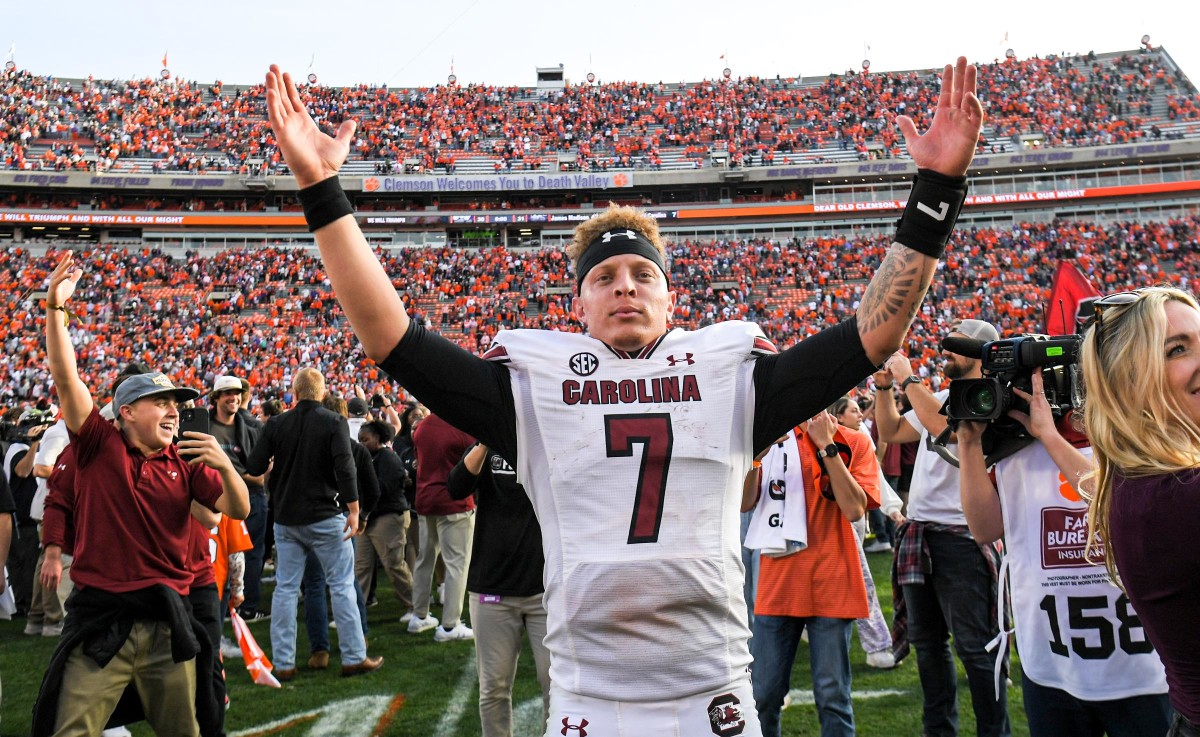
“Spencer’s been humbled in a good way,” Dilfer said. “My quarterback coach at UAB was his quarterback coach last year at South Carolina, so I watched all the cutups, have seen all the practice film. Has way more arm talent than people give him credit for. I’d say in this group, after Maye, Caleb, I might be missing one, but he has the arm that fits that big-time quarterback conversation. He’s a very good athlete, he’s football savvy, he’s been coached really well. I’d put Spencer with the Pratt kid, those would be two to keep an eye on.”
One NFL evaluator pointed to Rattler’s performance against Tennessee last year (he threw six touchdown passes against the Vols) as evidence of what he can do. “You watch that game, he looks like an NFL starter,” said the scout. “He has stuff to figure out, but there’s starting NFL talent in that kid’s body.”
Michael Penix Jr.
Sixth-year senior, Washington
Penix’s case isn’t unlike Nix’s. At a prior school (in this case, Indiana), Penix wasn’t seen as much of an NFL prospect. Then, before last year, he transferred to a Pac-12 school and took a big step forward as a passer.
So the question will be: How much of Penix’s breakthrough was the 6'3", 213-pound southpaw coming of age, and how much was Washington coach Kalen DeBoer’s innovative, quarterback-friendly system?
I spoke with Palmer the day after Penix threw at Elite 11 (the Husky was a counselor at the event), and Palmer expressed some surprise in saying, “He’s got a big ol’ arm,” then added, “He’s going to have a great year. And so I could see, from a ceiling perspective, him being considered in that [after Williams/Maye] group.” Dilfer, meanwhile, compared Penix to his own quarterback at UAB, Jacob Zeno, who transferred over from Baylor.
“He’s very natural at playing the position, he’s got a good feel for it, he’s studious, he’s smart, he’s talented, not uber-talented, but talented, he’s very accurate, throws a catchable ball,” Dilfer said. “All the boring stuff that makes you win, kind of Kirk Cousins–ish, I’d put Penix and my guy in that Kirk Cousins range, where nothing is flashy but everything is substantive.”
I’ve seen some mocks putting Penix in the first round. A couple scouts told me that’s doing him a disservice—because he’s not in that category. But he’s a good player with a shot to get better, who’ll also have to check out medically (he suffered two torn ACLs at Indiana).
Will Howard
Senior, Kansas State
I’m including Howard after listening to an exec talk about him, because he absolutely profiles as a player who could sneak up on people come November—a big, prototype quarterback who started a bunch of games as a true freshman, backslid as a sophomore, rode out an experienced starter (Adrian Martinez) transferring in his junior year, then starred when that starter got hurt.
At the very least, there’s opportunity in front of the one-time big recruiting get for Kansas State.
“I went in with no expectations,” the exec said, of doing the evaluation. “He plays like an NFL quarterback, he’s coming out of [Chris] Klieman’s offense, it’s pro style, it’s under center, it’s play-action. He sees the field, he’s accurate. He played a lot as a freshman and sophomore, and it wasn’t great, so they brought in the Martinez kid, they wanted to shelve him for a year, and Martinez got hurt and they put him back in and he played his balls off.
“He’s big, he can throw it. On tape, it looks easy for him. … Cool player.”
And one for you to file away.
Joe Milton III
Sixth-year senior, Tennessee
Likewise, this one is at the behest of an NFL exec, and is the result of another player taking a circuitous route to where he is now. Milton went into 2020 as Michigan’s starter and, throughout a disastrous season for the program, lost that starting job to McNamara. He then transferred to Tennessee, was named the starter there for ’21 and wound up losing the job in midseason to Hendon Hooker.
Now, he’s back, getting a third chance. And there’s a reason he keeps getting chances.
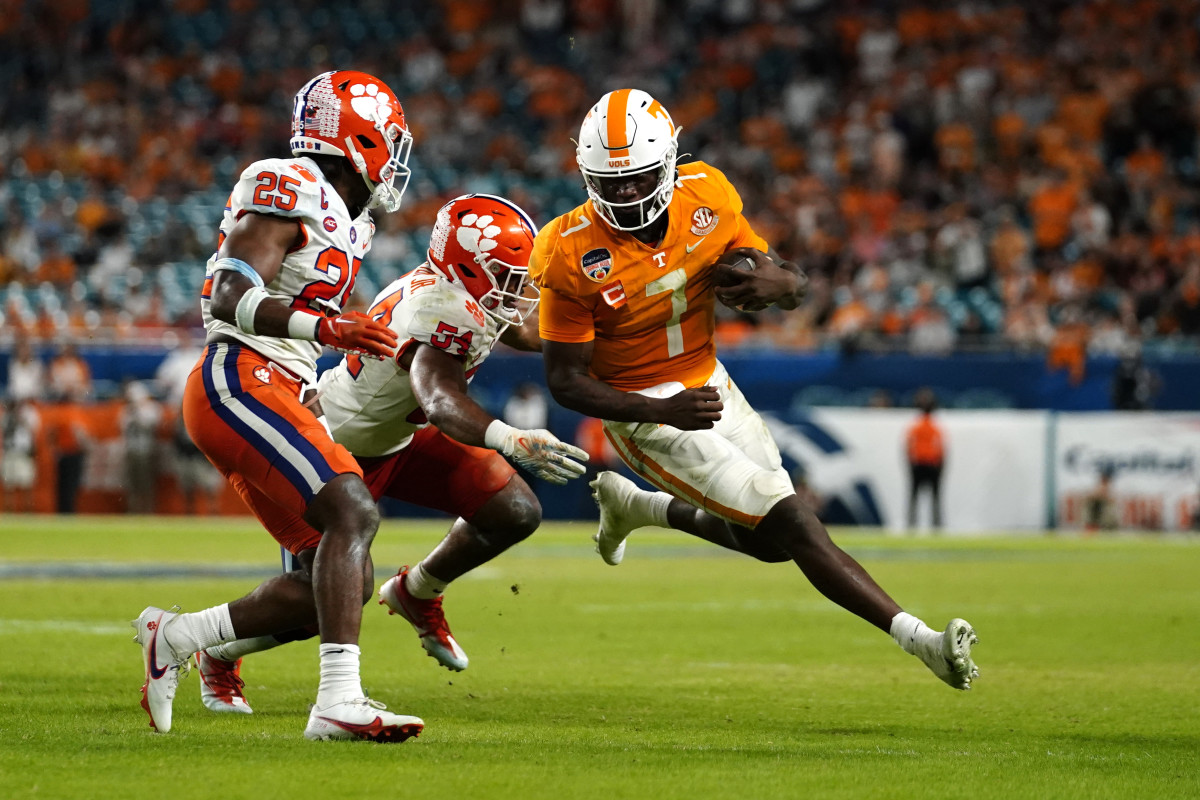
“I would keep a close eye on Milton,” said the scouting director. “They think he’s the next AR [Anthony Richardson] from last year, just because he’s gigantic and has one of strongest arms you’ll ever see. Historically, his accuracy has been poor. But if he can put the ball in the right zip code on a consistent basis, now we’re talking about a guy that’s going to get people’s attention.
“I think he will have tremendous numbers, he’s huge, and he throw it a mile.”
The impression Hooker makes as a rookie in Detroit could affect this one too, as could the departure of Josh Heupel’s offensive coordinator, Alex Golesh, to South Florida. It’s also worth noting that while Milton, at 6'5" and 244 pounds, is a very good athlete, he does not have nearly the same explosiveness that Richardson did.
And with that established, yes, this one is worth keeping an eye on.
Jayden Daniels
Fifth-year senior, LSU
This one is at the suggestion of Palmer, who sees Daniels as a player for whom an offensive system was finally built last season (his first in Baton Rouge after transferring to LSU from Arizona State).
“He may be a little bit of a sleeping giant,” Palmer said. “At other positions, they have a lot of guys, similar to Burrow’s year., where it’s like, because the overall team success wasn’t there, you don’t realize how good that guy is, and with the corner or the linebacker or the guard, if you really look at that roster, they got a chance. And if they got a quarterback, they got a chance. And so Jayden being as mobile as he is, he’s not a guy that ever turns it over. I’ve just seen him grow up a lot over the last few years.
“I think he’s poised for a monster year. And when you kind of have that monster year at a school like LSU, when you’ve got NFL guys on your roster, I mean, you can really climb in the draft.”
Daniels also, at 6'4", 200 pounds, has NFL height (he needs to put on weight), and 43 starts under his belt—which, after Brock Purdy’s early NFL success as a high-rep college player, is a nice box for a guy to check. The other thing to add here is that Palmer actually was the one that told me not to sleep on Burrow over the summer of 2019.
The rest ….
With our top dozen established, some more names that came up in our conversations …
• Washington State’s Cameron Ward transferred from Incarnate Word to Washington State last year, and while his outsized production of 2021 wasn’t duplicated in the Pac-12, he came close enough to turn some heads. “Dynamic athlete, really productive,” Palmer said. “I love his approach to the game. And he can rip it.”
• Kentucky’s Devin Leary transferred in from NC State, and will get the benefit of working with returning OC Liam Coen this season—the same coordinator who got the best out of Levis two years ago. “He’s gonna turn some heads,” said Palmer, “he catches people off-guard when you see him throw in-person.” Leary’s seen as having the potential to be, at least, a really good long-term backup.
• Taking Leary’s spot at NC State is Virginia transfer Brennan Armstrong, who some folks regarded as a potential mid-round pick going into his fifth year as a Cavalier in 2022. Under new coach Tony Elliott, things came undone for Armstrong (his completion percentage dropped by more than 10 points, his passer rating by close to 50). He will now get a shot to redeem himself at a rival ACC school.
• Colorado true junior Shedeur Sanders made the move from Jackson State with his dad, and he comes up to the FBS level with 24 FCS starts under his belt. Deion’s kid, in many ways, looks the part. We’ll know the rest soon. “Really good player,” Dilfer said. “Smooth—he’s in that smooth category, he’s effortless on some things. I need to see it at this level. … They’re gonna have adversity, it’s not all gonna be rainbows and roses, so how’s he responding to that adversity, how does he respond to the pressure of being Prime’s kid?”
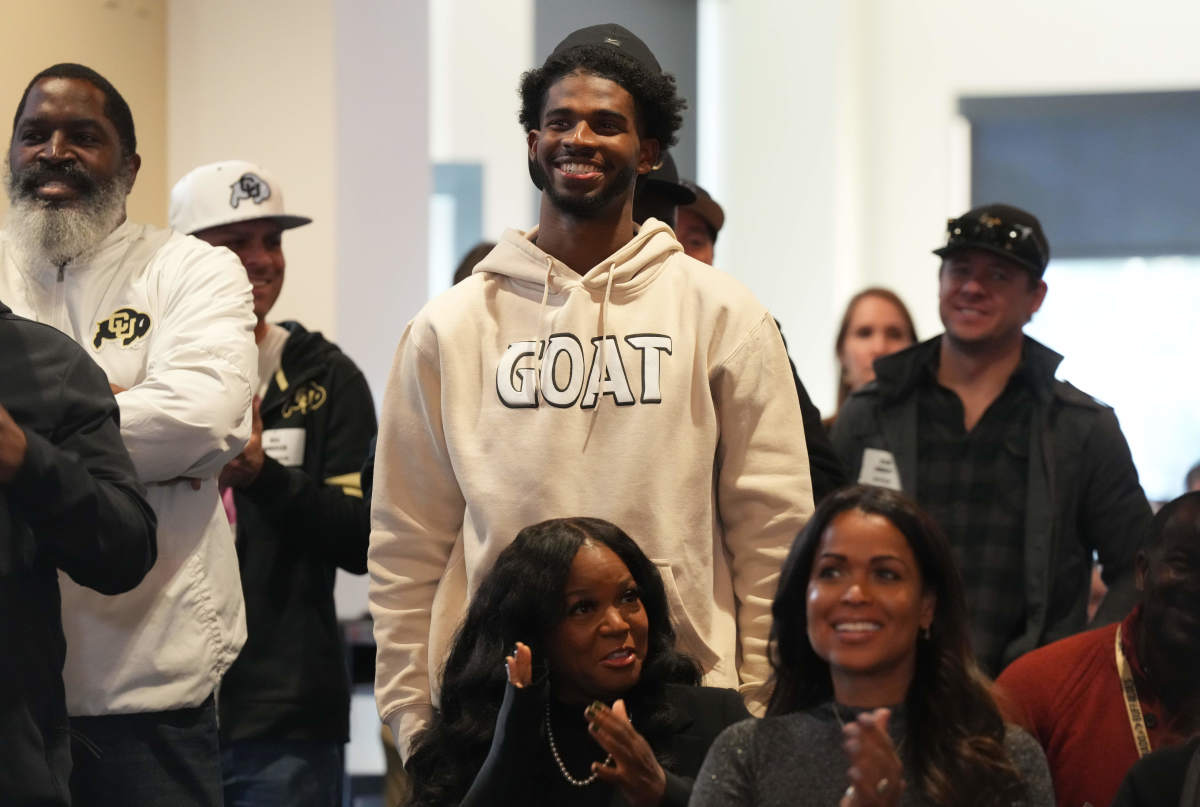
• You may remember Kedon Slovis from USC (where he played from 2019–21), or Pitt last year. This year, he’s at BYU, and while no one is looking at him like he’s the player starting at USC now, he did start there as a true freshman, and it’s fair to say, according to scouts, that Pitt’s scheme last year didn’t do him any favors. So if he can get back to his accurate, efficient self—and based on BYU’s recent history, the Cougars can probably get him there—Slovis will get his shot at the pros.
• If you like a good Tim Tebow comp, then Utah’s Cameron Rising is for you—he’s big, physical, and a winner through and through. “He’s kind of been a baller since he started playing football in high school at a record-book level in [California],” Palmer said. “And then he’s 2–0 vs. Caleb Williams, and gone toe-to-toe with everyone, super clutch, back-to-back Rose Bowls, back-to-back Pac-12 championships, and is coming off an ACL for this year.” Rising will be 25 next May, and he’s got a lot to prove as a passer. But … his track record is pretty good.
• To wrap up, we’ve got a sleeper: Western Kentucky’s Austin Reed. The 6'2", 230-pounder took the Bailey Zappe route, transferring up from a DII school (West Florida, in this case) to play for the Hilltoppers. And, Reed actually threw for more yards (4,744) and as many touchdowns (40) at WKU than he ever did at the lower level. So file that one away.
• … And then, we got four names worth watching, for various reasons. Oregon State’s DJ Uiagalelei, once the nation’s most sought-after high school recruit, has physical ability, and you could argue the Clemson offense dragged him down. Notre Dame’s Sam Hartman is transferring over from Wake Forest, going from a quirky, hyper-productive offense he starred in with the Deacons to a more conventional one in South Bend (which could help prove his NFL worth). And based on recent history, it’d be silly to dismiss draft-eligible guys vying to become starters at Alabama (Tyler Buchner) and Ohio State (Kyle McCord).
